Pickering blacksmithing history brought back to life
Published November 28, 2022 at 11:08 am
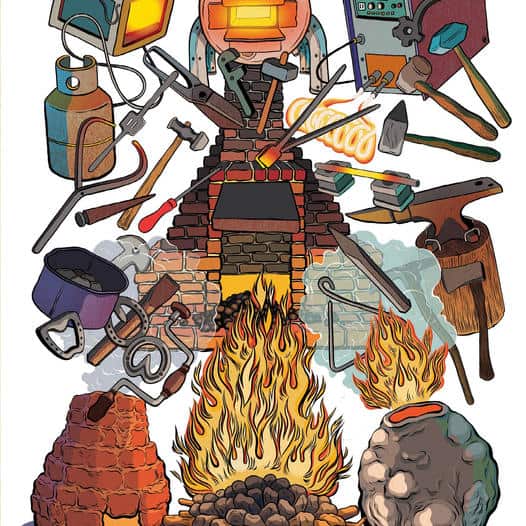
If there is anyone who can capture 175 years of blacksmithing at Pickering Museum Village in just seven images, it’s Oshawa artist Dani Crosby.
Crosby uses a blend of modern pop art and realism style to tell the story of the unique history of the Greenwood Blacksmith Shop and the impact the ‘Smithy’ had on the historical Pickering community.
Art is about telling a story through pictures and Crosby educates and celebrates the history of blacksmithing by telling its stories through seven pieces of art.
Images illustrate the history of farming that was possible in Pickering because of the blacksmith farriers, the history of horse racing locally only in large part made possible by blacksmiths, and celebrate Pickering Blacksmith artist Bill Lishman who worked in Greenwood Blacksmith Shop for many years. By engaging the community’s interests, curiosities, and knowledge of blacksmithing, Crosby has created seven images that represent the ways in that the trade has informed Pickering’s identity from country hamlet to bustling city.
Two of Crosby’s pieces will be installed as murals at Highway 7 and Concession Road 6 – in front of where the museum is located. The other artworks will be reproduced as banners to be installed in key areas of the city.

Oshawa artist Dani Crosby
“As a local Durham Region artist, it was an honour to create illustrations for the 175th Blacksmith Anniversary Project for the Pickering Museum Village,” Crosby said. “Honestly, this was one of those projects an artist could spend a year on, there is so much to learn and it is all very interesting. I took a lot of direction from the community, prioritizing the things they declared to be most important to them. It was also valuable to receive feedback that indicated an unawareness, in certain cases, of the history of blacksmithing and the Pickering community. This helped me design each piece as a potential entry point to inspire curiosity, self-education, and perhaps motivate people to engage with Pickering Museum Village.”
Images illustrate the history of farming that was possible in Pickering because of the blacksmith farriers, the history of horse racing locally only in large part made possible by blacksmiths, and celebrate Pickering Blacksmith artist Bill Lishman who worked in Greenwood Blacksmith Shop for many years. By engaging the community’s interests, curiosities, and knowledge of blacksmithing, Crosby has created seven images that represent the ways in that the trade has informed our city’s identity.
Two of Crosby’s pieces will be installed as murals at Highway 7 and Concession Road 6 – in front of where the museum is located. The other artworks will be reproduced as banners to be installed in key areas of the city.
“As a local Durham Region artist, it was an honour to create illustrations for the 175th Blacksmith Anniversary Project for the Pickering Museum Village,” Crosby said. “Honestly, this was one of those projects an artist could spend a year on, there is so much to learn and it is all very interesting. I took a lot of direction from the community, prioritizing the things they declared to be most important to them. It was also valuable to receive feedback that indicated an unawareness, in certain cases, of the history of blacksmithing and the Pickering community. This helped me design each piece as a potential entry point to inspire curiosity, self-education, and perhaps motivate people to engage with Pickering Museum Village.”
Crosby said feedback from the public was important to the process, as well as research through comments, opinions, perspectives, interests and priorities associated with the history of blacksmithing in Pickering.
“The influence of the historian and other museum employees I was in contact with during this project was also incredibly valuable. They took the time to educate me on the history, function, significance and meaning connected to the people, to the landscape, objects, tools, structures and more,” Crosby said. “I hope these images will inspire curiosity, create visual interest, and serve as potential starting points to further visual explorations of the past and present of this community. It brings me great joy to see my artwork out in my community and I hope it brings some enjoyment and sparks some interest during the time it is made accessible to the public.
Playing and Learning Together In The Village
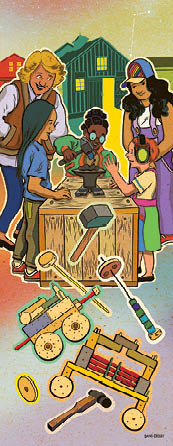
This piece celebrates Pickering Museum Village as a space for youth to learn, share and socially connect. The museum has some really great spaces and tools for hands-on workshops. I wanted to depict some of those tools and objects from both the forge room and the woodworking and painter’s space. But, the main focal point of this image is meant to be the group of youth, from different generations, engaging with each other in the context of learning and playing – all against a backdrop of buildings from the museum grounds and the sun rising into a starlit sky. I included the constellation Equuleus which is Latin for ‘little horse’ or foal, again connecting with the site and as a reference to youth.
People, Animals and Tools Feeding The Village
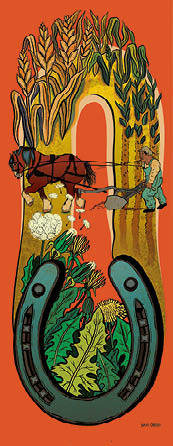
One of the important roles of the blacksmith emphasized in public feedback is that of the blacksmith as the individual responsible for the creation and maintenance of tools used by farmers and farriers to grow their crops. Without these important people, animals, and their combined skills communities would have been without food necessary for their survival. I wanted the horseshoe to dominate the image visually. It frames dandelions which represent resilience but also an example of plant life farmers had to contend with. Dandelions can shorten the productive life of crops. Symbolically the horse stands as a barrier between the dandelion seeds and the wheat crop. This is a Clydesdale horse, which in the 19th century served an important role in agricultural work. On the right side, wheat stalks can be seen thriving, blooming from seed to early stages of growth.
Bill Lishman, Life Long Learner Life Long Creator
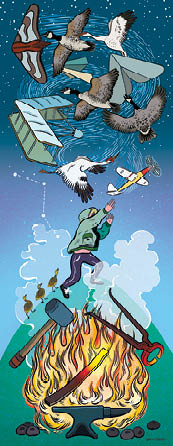
This image celebrates Pickering-based Blacksmith Artist Bill Lishman, who worked in Greenwood Blacksmith Shop. The design for this piece is inspired by my own enjoyment of Mr. Lishman’s art as well as “Wild Bill Lishman”, a documentary sent to me by producer Peter Shatalow.
At the top of the hill, you can find an illustration of Mr. Lishman as a child, throwing his toy aeroplane. As it rises up it turns into his first flyer, then another one of his flyers, until it reaches the top where you will find an illustration of his flyer as it was depicted in the movie “Fly Away Home”, which was written by Lishman. Interspersed among the flyers are some of the different kinds of birds he flew with and those at risk of extinction which his mother cared deeply about. There is also a paper aeroplane to represent playfulness, the ‘trouble-maker’ in school, and the relentless passion for learning Mr. Lishman exuded.
At the bottom of the design there is the anvil depicted in the documentary from his first blacksmith shop, the Greenwood Blacksmith Shop in The Pickering Museum Village. There are 7 coals with dents or holes representing the 7 domes of the unique underground home he eventually built. In and around the fire are some of his tools. There is smoke rising and sparks flying from the fire associated with forging. Moving up, the smoke becomes clouds in a blue sky and the sparks become stars in against the night sky, inspired by Mr. Lishman’s lunar sculpture, the 23-foot model of the lunar-lander Eagle. In the sky is the constellation Caelum representing the chisel of the woodworker which was significant to include as woodworking was his first step toward becoming a metal sculptor.
The Essential Support Of Repairing
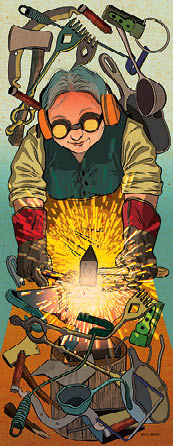
This image celebrates the essential role of the blacksmith in the context of the work they do to repair objects and tools. Feedback from the public pointed to the important role of the blacksmith as one who can repair and repurpose – and understandably so. From mending the link in a chain, sharpening the head of an axe, to correcting the warp in an iron pan, without the blacksmith to repair important tools and objects businesses and households would fail to function.
I wanted to explore the interesting shapes of various household objects and other tools. Starting at the bottom of the design you can see different warped and broken objects and tools. Moving upward, I wanted to visually explore the sparks that fly when the blacksmith’s hammer hits the hot metal. The blacksmith is wearing more modern gear as she makes her repairs. I wanted to mix together objects and tools from the earlier years of the site with a more modern blacksmith to celebrate the ongoing importance and progression of the role of the blacksmith. Above her, you can see the repaired tools and objects.
Supporting The Hooves On The Track
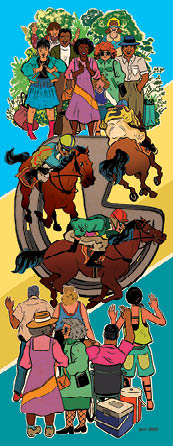
With this piece I wanted to illustrate the history of horse racing locally and how important the role of the blacksmith was who shaped the iron of the horseshoe. In the context of racing I found that different shaped horseshoes provided different kinds of support for the racehorses. In my reading I found that the two most common types of corrective shoes used in horseracing are Z-bar and V-bar. A Z-bar is used when a horse hoof has a quarter crack; it helps distribute the weight to heal correctly. This is why I choose to depict the Z-bar horseshoe and place the horses and jockeys speeding around it like a track.
The local connection to this is Ajax Downs, formerly Picov Downs. Ajax was actually part of Pickering Township from early surveying in the late 1790s until WW2 when the area around the munitions plant was severed to form its own municipality, the Town of Ajax. The enjoyment of racing and the relationship to the neighbouring community felt like an important connection to make with blacksmiths and the horseshoe in this context.
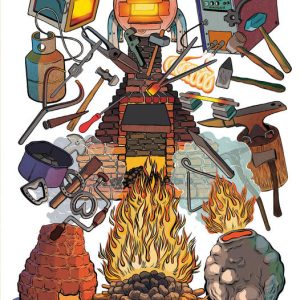
The tools of the trade depicted in this illustration were so visually and historically interesting to me. Each are as fascinating in their function as they are beautiful in their design. I wanted this image to explore a little bit of the history of the forge and blacksmithing tools as they have evolved over time.
At the bottom, charcoal and flame and wood moving inward slowly turning to charcoal. This open fire is followed on either side by the bloomeries, one older than the other. Both are just two examples from earlier times during the emergence of blacksmithing. I wanted to include depictions of fire and heat with special attention paid to the colours important to a blacksmith in metalworking.
As iron gets hotter and hotter it glows different colours. First red, followed by orange, yellow, and then white. I read that the ideal heat for the majority forging is the bright yellow-orange. A chart depicting visualizations of these temperature colours can be found at the museum. In the centre is the 1850’s anvil and forge of the museum. Moving up you can see the propane, gas and electoral induction forges.
Team Work and Generations In The Village
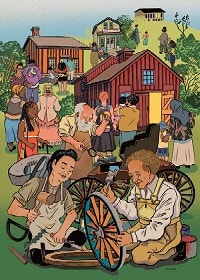
In the design, I wanted to show the important relationship between the blacksmith, the woodworker and the painter. I show them all connected through the work that goes into creating a carriage. Carriages were essential to trade, transport and survival at the time. Surrounding each of the figures are objects that represent some of the materials, stages of creation, and tools they used to complete the carriage. Most of the visual references for this piece can be found at the museum.
This includes the historical outfits worn by some of the people in the scene. In the middle ground, you will see The Greenwood Blacksmith Shop. The door is open and warm light shines through the doorway from the first level of the building where the forge can be found. The people depicted in this scene include people who have used and enjoyed the village throughout time up to the present day. This symbolically celebrates the historical use of the village and the current use of the village which benefits our current population as the village serves as a space to learn, share, and connect socially.
Visit http://bit.ly/3ELw05N to learn more about these pieces of art and others in the series.
This project is funded through the Building Communities Through Arts and Heritage, Legacy Fund.
insauga's Editorial Standards and Policies advertising





